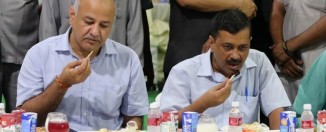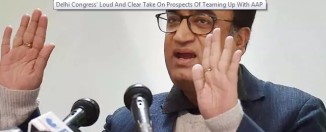Mamata Capture Kejriwal around Parliament: Why there’s more to this than meets the eye
On Wednesday when West Bengal Chief Minister and Trinamool Congress leader Mamata Banerjee took her Delhi counterpart and Aam Aadmi Party leader Arvind Kejriwal on a tour of Parliament House, she wasn’t merely acting as a guide. She was also sending out a strong signal to her rivals and opponents that she has him on her side of the fence for the Assembly elections in her state in the first half of 2016.
It did not matter that there may not be a formal tie-up or that neither the TMC may give nor AAP take a single seat out of the 294 going for polls. But the sheer act of having the AAP leader physically or notionally on her side is expected to lend weight to her campaign in reaching out to the minorities, the disadvantaged or to sections that place a premium on clean politics. More importantly, it is to thumb her nose at the Left parties with whom Kejriwal shares close links. The initiative was meant also to ensure that he did not link up with the Communists or field his own candidates in the state. And as she had done ahead of the Assembly polls in Delhi, she declared her support for the fledgling party for the 2017 state polls in Punjab and endorsed Kejriwal’s confidence of forming a government there.
Will Kejriwal return the compliment? There is no knowing as yet. But given his dilemma of choosing between the Left and his latest mentor, he maintained a cryptic silence when confronted with the question whether he would share the dais or campaign for the TMC. “When the time comes, we will decide,” he said..
Mamata’s action vis-à-vis AAP has been a replay of her backing and support for Nitish Kumar in Bihar both before and after the polls. With her recent backing to the Congress over its charge of a “political vendetta” in the National Herald case, she was also trying to dangle the carrot of a possible poll alliance with the party that had got nine percent of the votes in 2011 — despite their bitter fallout subsequent to the TMC’s victory and government-formation in the state — and prevent it from lining up with the Left.
But seeking out disparate political parties and leaders individually is only one part of the three concentric circles of her political power game in the changing political dynamics of the country in which the relevance and role of national parties is being defined or modified by regional forces or region-based parties.
At the second level, she has been trying to work with and bring chief ministers on a common platform at a bulwark against the Centre. She was part of the conclave that Kejriwal had organised to discuss the issue of collective federalism. And in January she plans to get chief ministers in Kolkata to deliberate on Centre-state relations where issues like Prime Minister Narendra Modi’s decision about a monthly interaction with state chief secretaries would be on the table. How many actually turn up for the meet remains to be seen.
At the third level, she has been talking about a non-Congress, non-BJP formation at every available opportunity in the last one year or so. AAP and JD-U’s victories in Delhi and Bihar have once again galvanised her into pushing for the idea of a federal or joint front. Although her efforts to set up one have not yet succeeded and her calls have often gone unheeded, they have sparked off speculation that she is aiming at a five-fold objective:
Displacing the Left as the fulcrum of unity in any non-Congress non-BJP; Becoming a national player as a leader of a combine towards the larger goal of perhaps becoming a prime ministerial candidate at some point; Neutralising the possible allies of the Left, the BJP and other parties that could pose a threat to her politics and standing; Shoring up her flanks against the moves over the scandals, including the Saradha scam, during her regime; and signalling to the ruling NDA and fence-sitters that the unity of non-Congress non-BJP parties can act as a powerful political pressure group in demanding and extracting their due, thereby preventing the Centre from trampling on their rights, authority and powers, and in steering national politics and discourse.
In August, she flagged the idea with a small get-together with NCP chief Sharad Pawar, JD-U chief Sharad Yadav, Samajwadi Party leader Mulayam Singh Yadav and the National Conference’s Farooq Abdullah.
The message of a coming together was signalled as early as 2012 during the presidential elections in 2012 when the SP-Trinamool bonding crumbled in 24 hours. Nitish Kumar’s swearing-in ceremony on 20 November in Patna provided another glimpse of this. The string of greetings from potential partners during Sonia Gandhi’s birthday on 9 December or the celebrations for Sharad Pawar’s 75th birthday on 10 December are among the occasions for sending out such signals.
On Wednesday, she in fact signalled that the TMC, the JD-U, AAP and the NCP were moving closer.
Will it actually happen or will it be another wishful display of intentions? But if they indeed get together, the reins will lie in the hands of Pawar and it is no big secret that the two leaders share a close political chemistry.
Should that happen, it will call for another headline.





